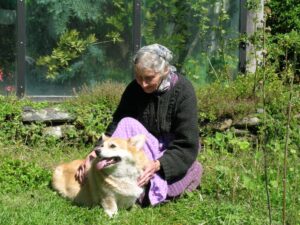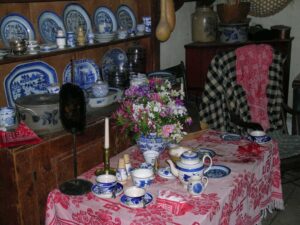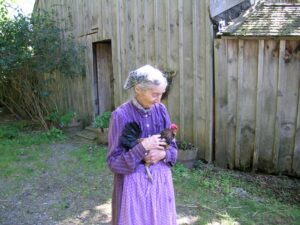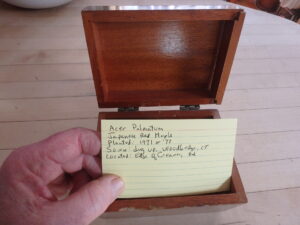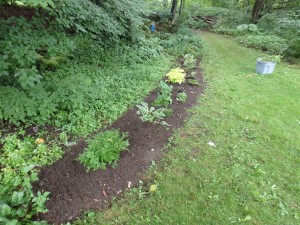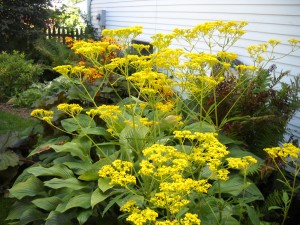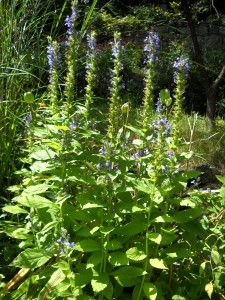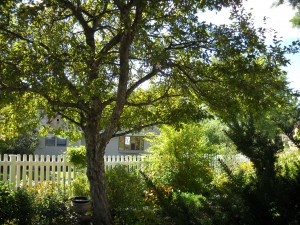Remembering Tasha Tudor (1915-2008)
Tasha Tudor, one of America’s favorite children’s book illustrators and writers – and a great gardener – died peacefully at home on June 18 at the age of 92. She sold her first book, Pumpkin Moonshine, in 1938 by going to New York and walking from publishing house to publishing house with her book under her arm until she finally sold it, after many rejections, to the New York office of Oxford University Press. Since that time she has illustrated about 100 books including classics like Little Women and The Secret Garden, and written several of her own books, including Corgiville Fair and Corgiville Christmas, which came out in 2002 – when she was 86.
An excellent cook who believed in the goodness of butter and cream, Mrs. Tudor had made a pineapple upside down cake in my honor. She loaded it with heaping spoonfuls of fresh cream she had whipped up just before my arrival, telling me she didn’t believe in the evils of cholesterol. She told me that once, when she was tired of waiting for a stone mason to show up to build a retaining wall behind her house, she put up a “Wanted” poster for him at the local post office. She offered a homemade pie as the reward for bringing him. The mason turned up the next day, claimed the pie, and began the work.
During our first visit she lamented that she wanted to plant more of her favorite crabapples, but that the varieties were no longer available. I found one for her at E.C. Brown’s nursery in Thetford, Vermont, and she had her son take there the very next day. She generally traveled with her pet rooster, Chickahominy, but no one at EC Brown’s remembers him being there that day. Maybe he was feeling tired – her Corgi, Meggie, loved to chase him. She told me that Chickahominy “likes to go motoring” and that for his ceaseless efforts controlling cutworms, he was “getting a PhD in entomology”.
It’s Time for Some Winter Planning
I like writing things down, using a real pen, sometimes even using my trusty fountain pen. Years ago I bought a 10-year Gardener’s Journal from Lee Valley Tool Company. They still sell them, and at about the same price: $32.90. It is hard-covered and durable. The only thing it lacks is a search function. It has a page for every day of the year, and 10 sections per page – a few lines for every day. In principle I would write the weather, what I planted or pruned or dug out every day. But life gets in the way of even the best of intentions.
So what will go on the cards? First I have to decide if I will use common names or scientific names for alphabetizing the plants. I will use the scientific names, as that is how I think of most of my plants. But I will also include common names. Date planted, source of the plant, where planted, perhaps soil amendments added or any other details that might be useful. If plants die, I will keep the card, but place a black dot on the upper right corner of the card.
Have Patience: Good Gardens Take Time
One of the things I have learned over the years is that a garden needs time to develop and reach its full glory. The late children’s book author and illustrator – and gardener extraordinaire – Tasha Tudor once told me, “You need patience. It takes twelve years to make a garden. Everything that’s worthwhile takes time.” That seems a bit too long, but it does take time – years, in fact.
Recently I’ve been working on a shade garden that needed a pick-me-up. It has always been great in the spring with daffodils, snowdrops and scilla. There are lots of wild flowers and perennials, too, starting with hellebores that blossom beginning in late March and that have glossy dark green leaves all summer. Then come the primroses, anemones, Brunneras and finally hostas. All are green and pleasant now, but not dramatic. There wasn’t enough contrast for my taste. I have lots of groundcover – spotted dead nettle, or Lamium maculatum – that provided green and white foliage – but it’s somewhat boring right now.
So I created a new 3-foot wide curved bed about 30 feet long that replaces some of that ground cover and adds life to the wider garden area behind it.
I started by preparing the soil. It’s a shade garden, which means that there are a lot of tree roots in the space I wanted to plant. I defined the new bed by stretching out a garden hose defining a gentle curve. Using a pointed spade, I cut a sharp line into the soil 8 inches deep all along the hose, and then parallel to that 3 feet back from it.
Next I used a 4-tined weeding fork to pull the ground cover from the soil. This is a nice Italian tool made in a factory that has been making them the same way for generations. I got mine from Howland Tools in Shelburne Falls. MA (http://www.howlandtools.com). The curved12-inch long tines comb through the soil, finding and lifting roots. It’s like a 4-tined rake with extremely long tines. Some also call it a potato fork.
Tree roots were plentiful in my new bed so much of the soil’s fertility had been taken up long ago. The trees also suck water out of the soil, so removing roots helps in the short term (though I know they will return). I added organic slow-release fertilizer (one called Pro-Gro) and lots of compost – a couple of inches of it everywhere. I mixed it into the soil with that weeding fork, and then watered it repeatedly. Extra dry soil takes a long time to absorb water.
Since I like to plant according to the cycles of the moon, planets and stars, I consulted my Stella Natura calendar (www.stellanautra.com) and waited for a day auspicious for planting flowers. As it turned out, that was also a rainy day – the first in a long time here.
So what did I plant? In the middle I planted a perennial known as spikenard or Aralia cordata, one called ‘Sun King’. It gets to be a big plant, maybe 3 feet tall and wide, and has brilliant yellow-green leaves and does well in shade or part shade. Nearest the spikenard I wanted contrasting foliage, so I planted a black-leafed bugleweed (Ajuga reptens ‘Black Scallop’) and a glossy, dark green-leafed European wild ginger (Asarum europaeum).
Other plants I dug up and moved there were barrenwort (Epimedium spp.), two sizes of goatsbeard (Aruncus spp.) and a medium-sized green and white hosta. All were plants I had elsewhere. I matched the planting so that each side of the gardenwas a mirror image of the other – or as much as one can do with plants.
I spaced the plants based on how big they will be in 3 years. That means 2 or 3 feet apart for full-sized perennials. Of course that means the garden looked a little sparse when first planted, so I got a few annuals to fill in. I also planted some forget-me-not (Myosotis sylvatica) to transplant into empty spaces. That’s an annual or biennial with early spring blue flowers that grows everywhere in my gardens, hundreds of them. Thousands, perhaps. It’s a great filler.
The day after planting my flowers I went up to E.C. Brown Nursery in Thetford, Vermont to see about some shrubs to add to the mix. I got two pagoda dogwoods (Cornus alternifolia) to plant behind the newly planted border. Pagoda dogwood grows well for me –it’s a native shrub that often pops up in shady places.
Why did I need to buy two more? They had some with variegated-leafed specimens with green and white leaves. Leaves with some white look good in dark, shady places. These understory trees are small, and will take 4 or 5 years to get to a size where they’re dramatic. But that just goes back to what Tasha Tudor told me: Everything that’s worthwhile takes time. And maybe she’s right, maybe I’ll still be tweaking plantings in thisgarden for the next 12 years.
Henry is the author of 4 gardening books. Read his twice-weekly blog posts and see lots of photos by going to https://dailyuv.com/gardeningg
How Long Does it Take to Create a Mature Garden?
Several years ago I interviewed the late Tasha Tudor, the reclusive illustrator and author, at her garden in southern Vermont. One question I asked her was, “How long does it take to create a garden?” Her answer, as reported in my book Organic Gardening (not just) in the Northeast, was succinct. “It takes twelve years to make a garden. Everything takes time that’s worthwhile.” I find that fascinating in light of recent visits to the gardens of Susan Weeks, of Lebanon, NH. Her lovely mature gardens were started around the year 2000 – some 12 years ago. And although Susan says they are still a work in progress, hers would make most gardeners ready to sit back and just admire them.
Susan moved into her house in 1995 with the idea that it was her final move: “I knew this was going to be my last home – the canvas I was going to be working on for the next 40 years – or until they drag me out of here.” When she moved in, her landscape consisted of a modern white house on a green lawn with just a few trees – a small blue spruce, a white pine and a rug of juniper on either side of the front door. It took her awhile to decide what to do, but by 2002 she decided to start planting some trees.
Susan decided to spend her money on trees that were already of fair size – at least 2 inches in caliper (diameter). She knew that she could cut corners and buy from a big box store, but doesn’t think it makes sense to do so. “I believe in buying local. They (locals) know what works here. It might be more expensive, but it works out better for everyone,” she told me. Over a few years she had a crab apple, two sugar maples, a Japanese tree lilac and a Japanese red maple installed. She kept them watered, made sure the lawnmower stayed away, and now these trees provide shade and beauty.
A mature woman of relatively small stature, Susan knew that these trees would best be installed by someone else, so she hired E.C. Brown Nursery of Thetford, Vermont to supply the trees and plant them. “As you get older, if you have some heavy work that needs to be done, it makes sense to get somebody it to do it for you.” That allowed her to work on the perennial gardens that she has developed over the past 10 years.
Gardening should be fun, and should be consistent with a gardener’s value system. Susan has two adorable old dogs that have grown up in her gardens, and she decided from day one that no chemicals would be used in her gardens – she didn’t want to risk harming Zoe and Maggie, her dogs. She fenced in part of the yard so the dogs would have a nice place to lounge around, and trained them to respect the flower beds while allowing them places to dig holes to lie in on hot days. Over the years she has expanded the fencing 3 times (as her budget allowed, I suppose) and the 4-foot tall white picket fence now encloses just about all of her property. There is a buffer zone, also planted, between the fence and the street.
Susan started planting perennials, adding the more each year. She has plenty of common flowers: bee balm, hostas, daylilies, iris, and black-eyed Susans. But after awhile, she took a four-evening class on gardening and started to get more confidence. She craved more interesting and unusual plants.
She tried Canadian burnet (Sanguisorba canadensis), great blue lobelia and ligularia. She got things with no common name like Persicaria superbum. Right now she has a tall shade-loving plant with bright yellow flowers that I’d never seen before, one she got from Cider Hill Gardens in Windsor, Vermont. It’s a Patrinia (no common name) and it’s not clear if it is a P. triloba or a P. gibbosa. I must get one.
At some point Susan decided she needed a small water feature, and created a little pond about 8 feet long and 3 to 4 feet wide with a pump that shoots a gentle stream of water into the air. She dug the hole herself, lined it with a special rubber liner, and covered the edges with flat stones. “A weekend project,” she said. She put in goldfish – and moved them indoors each winter to keep them alive. She told me that the sound of the bubbler is good for attracting birds. She loves the birds – another good reason for using all organic products.
Over time Susan has introduced flowering shrubs to her landscape, saying that as one gets older it’s important to have lower-maintenance plants. She is moving away from perennials that need to be dug and divided on a regular basis. Among the shrubs she has planted are weigela, hydrangeas, lilacs, ninebark, fothergilla; blueberry (for fall foliage); beauty bush; viburnum, daphne, Clethra, butterfly bush and others. She has a dog-eared copy of Taylor’s Guide to Shrubs, and each time she plants a new shrub she ticks it off in the book and writes the date planted.
And although Susan says she is cutting back, slowing down, I noticed that she had just excavated a new bed outside her fence. And she is eyeing a bit of lawn by the street. “Grass – it’s just one big perennial. It’s okay to dig some up for other perennials.” I can’t wait to see what happens in her gardens after she retires from her job in a few years.
Henry Homeyer’s upcoming kid’s book, Wobar and the Quest for the Magic Calumet, will be on shelves in October.



